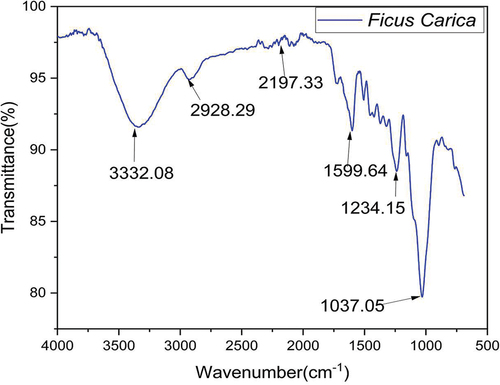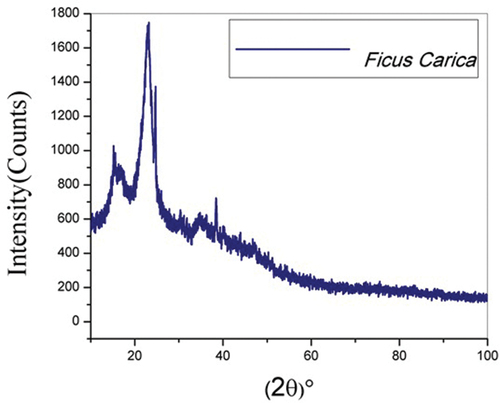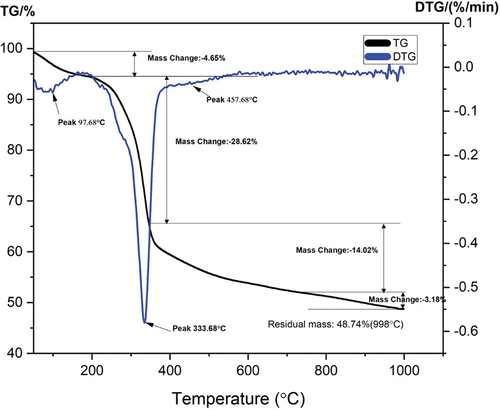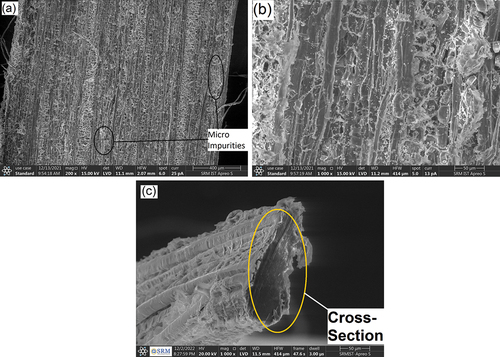 ?Mathematical formulae have been encoded as MathML and are displayed in this HTML version using MathJax in order to improve their display. Uncheck the box to turn MathJax off. This feature requires Javascript. Click on a formula to zoom.
?Mathematical formulae have been encoded as MathML and are displayed in this HTML version using MathJax in order to improve their display. Uncheck the box to turn MathJax off. This feature requires Javascript. Click on a formula to zoom.ABSTRACT
High specific strength and modulus of fiber-reinforced polymer composites tend to be the reason for replacing many metallic structures. Synthetic fiber (E-glass) becomes a risk for health and leads to cancer. Ficus Carica (FC) bark fiber undergoes comprehensive characterization analysis such as Thermal Gravimetric Analysis (TGA), Fourier-transform infrared spectroscopy (FTIR), X-ray diffraction (XRD), Scanning Electron Microscopy (SEM), Physical analysis and Chemical analysis. Bark of Ficus Carica plant is taken and the fibers are extracted. It is essential to study microstructure, chemical composition and mechanical properties of the fiber to utilize these lignocellulosic fibers as a reinforcement material in polymer composites. The results of this investigation are very encouraging for its applications to be used in industries for manufacturing fiber composites. FC Bark Fiber (FCBF) contains high cellulose content such as 63.17% and very little wax (0.42%). Good thermal stability of the fiber up to 225°C was produced from thermogravimetric analysis, which is well indicated within its polymerization process temperature. FCBF’s exhibit suitable properties that are to be used as natural reinforcement material.
摘要
纤维增强聚合物复合材料的高比强度和模量往往是取代许多金属结构的原因。合成纤维(E-glass)对健康构成风险并导致癌症. 通过热重分析(TGA)、傅立叶变换红外光谱(FTIR)、X射线衍射(XRD)、扫描电子显微镜(SEM)、物理分析和化学分析等综合表征分析。取无花果的树皮,提取纤维. 研究纤维的微观结构、化学成分和力学财产对于将这些木质纤维用作聚合物复合材料的增强材料至关重要. 这项研究的结果对于其在制造纤维复合材料的工业中的应用是非常令人鼓舞的. FC树皮纤维(FCBF)含有高纤维素含量,如63.17%和极少量的蜡(0.42%)。热重分析表明,纤维在225°C以下具有良好的热稳定性,这在其聚合过程温度范围内得到了很好的证明. FCBF具有适合用作天然增强材料的财产.
Introduction
In recent times, consumption of petroleum resources has increased, while increasing environmental regulations have initiated the research on renewable, recyclable, and biodegradable composite materials (Mylsamy et al. Citation2023 Mohanty, Misra, and Drzal Citation2002; Mylsamy et al. Citation2020). There are several advantages of natural fibers such as acceptable specific strength, low cost, low density, better thermal and acoustic insulating properties in contrast to conventional reinforcement material (Aruchamy et al. Citation2022; Manivel, Prabesh, and Bhuvaneshwaran Citation2023; Mylsamy et al. Citation2020; Nagappan et al. Citation2021; Shaker et al. Citation2020, Citation2022). Mechanical properties of the fibers still depend on factors like maturity and origin of the plant as well as the methods and techniques implemented to extract fibers from the stem (Bhuvaneshwaran, Sampath, and Sagadevan Citation2019) for every good alternative material without compromising the mechanical properties of the fiber, these are some better fiber yielding plants that are reasonably priced. In comparison, natural fibers were harmless, renewable, biodegradable, eco-friendly, and economical with high specific strength (Bhuvaneshwaran et al. Citation2021; Shaker, Nawab, and Jabbar Citation2020), Ficus Carica (FC) is one such plant, and it is most accessible in tropical regions of India. In this study, a fiber of Ficus Carica Bark Fiber (FCBF) is chosen for examination of mechanical, chemical, thermal and physical properties and SEM analysis and it is compared with other identified natural cellulosic fibers. Attention of researchers turns toward natural fiber which exhibit potential properties of reinforcement materials either with thermoset or thermoplastic matrix, namely coir (Dicker et al. Citation2014) flax (Goutianos et al. Citation2006), jute (Ahmed and Vijayarangan Citation2007), sisal (Li, Mai, and Ye Citation2000), hemp (Madsen et al. Citation2007). In bio-composite material community, identifying natural fibers turned out to be a challenge for researchers, due to its narrow range. For instance, from the study of last five years, cellulose based natural fibers such as Coccinia Indica (Balu et al. Citation2020), Calotropis gigantea (Ganeshan et al. Citation2018), Lavender (Eyupoglu and Merdan Citation2021) Calotropis procera (Yoganandam et al. Citation2020) have been recommended as notable alternatives to reinforced new composites. Urtica dioica is a natural fiber which was chosen for study and it was reported that this fiber can be used to fabricate environment-friendly natural fiber reinforced composites (Bodros and Baley Citation2008). Fiber reinforced composites are broadly used in automotive sector (Mylsamy et al. Citation2019; Thakur, Thakur, and Gupta Citation2014). Banana fiber reinforced with epoxy resin composite was determined to be as eco-friendly material as household telephone stand and it is also utilized for manufacturing household appliances with minimum cost (Bhuvaneshwaran et al. Citation2019). It is found from recent research papers, that natural fiber composite and its low density play an important part in manufacturing lighter weight component. In this study, an experiment is done to study morphology characterization and thermo-physico-mechanical properties of Ficus Carica bark fiber and it is introduced as novel natural fiber.
Materials & experiments
Fiber extraction
The matured FC bark were found and collected from Thailavaram village, Chengalpattu district, Tamilnadu State, South India, which is a medicinal plant under the family of Mulberry (Badgujar et al. Citation2014). depicts FC plant and extracted FC bark fiber after microbial degradation. In this process, the FC bark was immersed in water for three weeks to allow microbial degradation. The outer layers were removed manually followed by removal of the inner fibrous layers from FC bark. The fibers were then washed and sundried for one week, and were extracted from the dried FC bark through combing process, which was carried out by metal teeth brush (Bhuvaneshwaran, Sampath, and Sagadevan Citation2019).
Chemical composition and physical property
To determine the percentages of cellulose, hemicelluloses and lignin contents of FCBF is common analysis methods were applied (Doree Citation1950; Pearl Citation1967). ASTM D 1577–07 (2012) standards was employed to evaluate the density of FCBF (Indran, Raj, and Sreenivasan Citation2014). The content of wax evaluate as per the common protocol (Conrad Citation1944). ASTM standard E1755–01 was used to analyze the ash content (Reddy and Yang Citation2008). For a randomly selected sample of FCBFs, a tensile test was conducted using an universal testing machine equipped with a load cell of 1 kN and a cross head speed of 0.1 mm/min. The test was conducted according to ASTM 3822 M14. Gauge length used was 50 mm.
Fourier transform infrared (FTIR) spectroscopy
The existence of free functional groups on the FCBF was determined using FTIR spectrometer (Perkin Elmer RXI FTIR tester). As a function of wave spectral outputs were recorded between of 400–4000 cm−1 using 32 scans per second and were obtained in transmittance mode.
X-Ray diffraction (XRD) analysis
The powder X-ray diffraction technique was used to find out the crystallinity of FCBF. X’PERT PRO diffractometer was used for analysis with condition viz. current 30 mA, tension of 40 kV generator setting with Cu anode substance at 25°C temperature with 0.05 (2θ step size). CuKα radiation wavelength of 0.154 nm diffracted intensity was obtained between 10 and 80. Crystalline of cellulose concerning amorphous materials is measured using Crl (Crystallinity). The expression used to compute Crl is as follows (Segal et al. Citation1959) of FCB fiber.
Where,
Crl : Relative degree of the crystallinity
I002 : Maximum Intensity
Iam : Minimum Intensity
Scherer’s equation (Equation 2) used to find crystallite size (L) of FCBF (Park et al. Citation2010).
Where,
λ : wave length of the radiation
β : field width at half maximum (FWHM)
k : Scherer’s constant (0.94)
Thermogravimetric analysis (TGA)
Thermogravimetric (TG and DTG) analysis was used to assess the thermal stability characteristic of the FCBFs. Analyses was carried out using the model STA, NETZSCH, Germany. At the rate of 20 ml/min, nitrogen gas was exposed to testing atmosphere for avoid oxidation effects the TGA analysis. Thermocouple method was used to measure the temperature of the sample by crushing 10 mg of FCBFs and held in an alumina crucible for better coupling among the samples. Heating rate of the fiber is measured step by step beginning with the atmosphere temperature to 1000°C, that is, the step addition of the heating rate was from 10°C/min over a span of temperature.
Surface morphology of the FCBFs by scanning electron microscopy (SEM)
The surface of FCBFs was examined using a scanning electron microscope (CARL ZEISS model V18), Before SEM observations, the specimens were coated with thin gold layer on the surface of FCBFs to avoid gathering of electrical charges during examination.
Results and discussions
Chemical – physical analysis of FCBF
Mechanical, fire resistance, and biodegradability properties were highly influenced by the chemical constitution of cellulose fibers. Mechanical properties of the fibers were enhanced due to the contribution of FCBFs high cellulose content (63.17 wt.%) (Baley Citation2002). The strength of fiber is decreased due to the existence of hemicellulose content as it leads to deterioration of micro fibrils. It was found that FCBFs contains 12.08% of hemicelluloses content (Morvan et al. Citation1990) and it significantly influences the thermal degradation, moisture absorption and biodegradability properties of natural fibers (Thakur, Thakur, and Gupta Citation2014). The FCBFs rigidity was influenced due to the presence of lignin of about 13.7 wt.% (Manivel et al. Citation2021). Wax content influences the interfacial bonding among the fiber and matrix during manufacturing of composite materials (Sreenivasan et al. Citation2011). FCBF contains minimal wax of 0.42 wt.% that is comparatively low with Calotropis procera and Acacia leucophloea (Arthanarieswaran, Kumaravel, and Saravanakumar Citation2015; Yoganandam et al. Citation2020). present the chemical composition, mechanical, and physical properties of FCBF and compared with various natural fibers. The cell wall structure and chemical composition of the fiber significantly influences the tensile strength of the fibers. The density of FCBF is afford to achieve lightweight structural applications.
Table 1. Chemical compositions and density of raw FCBFs and different natural fibers.
FTIR analysis
presents the result of FTIR analysis used to find functional groups present in FCBFs on the prepared samples. From , the peak 1037.05 was co-related to the C-O of stretching of cellulose (Amutha and Senthilkumar Citation2021). Presence of acetyl groups of lignin is indicated from the peak at 1234.15 and the presence of C-C stretch is indicated the aromatic rings by the band around 1599.64 cm−1 (Gopinath, Billigraham, and Sathishkumar Citation2022). A typical band for C-H stretching vibration from cellulose constituent was predicted at the peak 2928.29 cm−1, O-H stretching vibration and hydrogen bands of hydroxyl group were caused at the peak 3332.08 cm−1 (Indran and Edwin Raj Citation2015).
XRD analysis
X-Ray diffraction spectrum of FCBF’s is shown in . Cellulose content is clearly indicated at the peak 2θ = 22.37° (200). Typically non-cellulose materials like lignin, wax etc., were shown at the peak 2θ = 15.18° (100). Crl of FCBF is found as 41.42%, which is greater than Borrassus (38.4%), Cyperus pangorei (41%) and Grewia tilifolia (41.7%) (Manivel et al. Citation2021). Scherer’s equation used to find crystallite size (L) of FCBF (Park et al. Citation2010), 5.51 nm is found to be value of L, which is higher than althaea (2.4 nm) and ferula (1.6 nm) (Nagarajan and Balaji Citation2016). presents the Crystallinity index and crystallite size of FCBF and various natural fibers.
Table 2. Mechanical, crystalline and thermal properties of raw FCBFs and various natural fibers.
TGA analysis
Thermal stability of the FCB fiber was determined using thermal analysis. FCBF starts degradation from 97.68°C, which leads to weight loss because of evaporation of water in the fiber. shows TG and DTG curve indicating thermal stability at 225°C and from that a considerable peak was observed between 200°C and 300°C, which is corresponding to thermal depolymerization of hemicelluloses content.
Breakdown of α-cellulose was indicated from the prominent peak at 333.68°C with 28.62% of weight loss. Nevertheless, similar peaks were noticed at 321°C, 376°C, 298°C, 331°C, 321°C for Hemp, Coccinia Indica, Jute, Prosopis juliflora, bamboo fibers, correspondingly (Yao et al. Citation2008). present the thermal stability of FCBF and different natural fibers. Lignin structure contains complex composition of aromatic rings which has a number of branches and hence decomposition take place at minimum weight loss rate within its whole temperature and varies from ambient to a temperature higher than 700°C (De Rosa et al. Citation2010). Oxidative degradation in charred residue may result in above the peak value such as 457.68°C. A higher degradation temperature is required for greater crystalline structure (Yang and Kokot Citation1996).
SEM analysis of FCBF
High resolution SEM images used to examine the structure of FC bark fiber surface shown in depicts the presence of microcracks and holes along the longitudinal direction of the fiber. Between fiber and matrix, these cracks and holes in polymer matrix could make high contact area. SEM images indicate which colored micro particles may be seen due to the existence of amorphous constituents in fiber such as hemicellulose, lignin and cellulose (Gopi Krishna, Kailasanathan, and Nagaraja Ganesh Citation2020). shows the multicellular structure arrangement in the surface of the FC bark fiber. White layer indicates the existence of impurities on the surface of the fiber. Those samples were treated chemically to eliminate impurities that would enhance the interfacial adhesion with polymer matrices, and natural fibers (Fiore, Scalici, and Valenza Citation2014). shows the cross-section of FC bark fiber.
Conclusion
This study indicates the main need of natural bark fiber for the preparation of polymer composite, which can be used as reinforcement material and also adds merit to the understanding of natural bark fibers. While comparing existing natural fibers, high cellulose content of FCB fiber with lower density, may be efficient in making light weight composite applications. The controlled and large-scale cultivation of the plant is encouraged to meet the demand of the light weight polymer composites and pulp and paper production industries. FCBF is the best alternative material for conventional fibers such as glass and carbon on polymer matrices since it contains desirable tensile properties. Relatively lower elongation and higher strength, are conferred to FCBF’s by the good value of Crl and magnitude of crystallize size. FCBF thermal stability up to 225°C was discovered through thermogravimetric analysis. Future studies will include a comprehensive investigation of FCBF reinforcement material for manufacturing biocomposite laminates and it is important to evaluate the thermal and mechanical properties.
Highlights
Extraction of new natural cellulose fiber from Bark of Ficus Carica Plant.
Fibers were rich in cellulose content found by chemical composition testing methods.
Fibers were characterized such as XRD, FTIR, TGA, and SEM performed.
Chemical compositions and density of raw Ficus Carica Bark Fiber and different natural fibers.
Mechanical, crystalline, and thermal properties of raw Ficus Carica Bark Fiber and various natural fibers.
Acknowledgments
The authors would like to thank SRM Institute of Science and Technology, Kattankulathur, Chennai, India. India for providing their lab facilities to test the samples.
Disclosure statement
No potential conflict of interest was reported by the authors.
References
- Ahmed, K. S., and S. Vijayarangan. 2007. Experimental characterization of woven jute-fabric-reinforced isothalic polyester composites. Journal of Applied Polymer Science 104 (4):2650–10. doi:10.1002/app.25652.
- Amutha, V., and B. Senthilkumar. 2021. Physical, chemical, thermal, and surface morphological properties of the bark fiber extracted from acacia concinna plant. Journal of Natural Fibers 18 (11):1661–74. doi:10.1080/15440478.2019.1697986.
- Arthanarieswaran, V. P., A. Kumaravel, and S. S. Saravanakumar. 2015. Characterization of new natural cellulosic fiber from Acacia leucophloea bark. International Journal of Polymer Analysis and Characterization 20 (4):367–76. doi:10.1080/1023666X.2015.1018737.
- Aruchamy, K., S. P. Subramani, S. K. Palaniappan, S. K. Pal, B. Mylsamy, and V. Chinnasamy. 2022. Effect of blend ratio on the thermal comfort characteristics of cotton/bamboo blended fabrics. Journal of Natural Fibers 19 (1):105–14. doi:10.1080/15440478.2020.1731903.
- Azeez, T. O., D. O. Onukwuli, J. T. Nwabanne, and A. T. Banigo. 2020. Cissus populnea fiber - unsaturated polyester composites: Mechanical properties and interfacial adhesion. Journal of Natural Fibers 17 (9):1281–94. doi:10.1080/15440478.2018.1558159.
- Badgujar, S. B., V. V. Patel, A. H. Bandivdekar, and R. T. Mahajan. 2014. Traditional uses, phytochemistry and pharmacology of Ficus carica: A review. Pharmaceutical Biology 52 (11):1487–503. doi:10.3109/13880209.2014.892515.
- Baley, C. 2002. Analysis of the flax fibres tensile behaviour and analysis of the tensile stiffness increase. Composites: Part A, Applied Science and Manufacturing 33 (7):939–48. doi:10.1016/S1359-835X(02)00040-4.
- Balu, S., P. S. Sampath, M. Bhuvaneshwaran, G. Chandrasekar, A. Karthik, and S. Sagadevan. 2020. Dynamic mechanical analysis and thermal analysis of untreated Coccinia indica fiber composites. Polimery 65 (5):357–62. doi:10.14314/polimery.2020.5.3.
- Bhuvaneshwaran, M., P. S. Sampath, S. Balu, and S. Sagadevan. 2019. Physicochemical and mechanical properties of natural cellulosic fiber from Coccinia Indica and its epoxy composites. Polimery 64 (10):656–64. doi:10.14314/polimery.2019.10.2.
- Bhuvaneshwaran, M., P. S. Sampath, and S. Sagadevan. 2019. Influence of fiber length, fiber content and alkali treatment on mechanical properties of natural fiber-reinforced epoxy composites. Polimery 64 (2):93–99. doi:10.14314/polimery.2019.2.2.
- Bhuvaneshwaran, M., S. P. Subramani, S. K. Palaniappan, S. K. Pal, and S. Balu. 2021. Natural cellulosic fiber from Coccinia Indica stem for polymer composites: Extraction and characterization. Journal of Natural Fibers 18 (5):644–52. doi:10.1080/15440478.2019.1642826.
- Bodros, E., and C. Baley. 2008. Study of the tensile properties of stinging nettle fibres (Urtica dioica). Materials Letters 62 (14):2143–45. doi:10.1016/j.matlet.2007.11.034.
- Conrad, C. M. 1944. Determination of wax in cotton fiber, a new alcohol extraction method. Industrial Engineering Chemistry, Analytical Edition 16 (12):745–48. doi:10.1021/i560136a007.
- De Rosa, I. M., J. M. Kenny, D. Puglia, C. Santulli, and F. Sarasini. 2010. Morphological, thermal and mechanical characterization of okra (Abelmoschus esculentus) fibres as potential reinforcement in polymer composites. Composites Science and Technology 70 (1):116–22. doi:10.1016/j.compscitech.2009.09.013.
- Dicker, M. P., P. F. Duckworth, A. B. Baker, G. Francois, M. K. Hazzard, and P. M. Weaver. 2014. Green composites: A review of material attributes and complementary applications. Composites: Part A, Applied Science and Manufacturing 56:280–89. doi:10.1016/j.compositesa.2013.10.014.
- Doree, C. 1950. The methods of cellulose chemistry. 2nd ed. New York: Springer US.
- Eyupoglu, S., and N. Merdan. 2021. Physicochemical Properties of New Plant Based Fiber from Lavender Stem. Journal of Natural Fibers 19 (14):9248–58. doi:10.1080/15440478.2021.1982816.
- Fiore, V., T. Scalici, and A. Valenza. 2014. Characterization of a new natural fiber from Arundo donax L. as potential reinforcement of polymer composites. Carbohydrate Polymers 106:77–83. doi:10.1016/j.carbpol.2014.02.016.
- Ganeshan, P., B. NagarajaGanesh, P. Ramshankar, and K. Raja. 2018. Calotropis gigantea fibers: A potential reinforcement for polymer matrices. International Journal of Polymer Analysis and Characterization 23 (3):271–77. doi:10.1080/1023666X.2018.1439560.
- Gopi Krishna, M., C. Kailasanathan, and B. Nagaraja Ganesh. 2020. Physico-chemical and morphological characterization of cellulose fibers extracted from sansevieria roxburghiana schult. & schult. F Leaves. Journal of Natural Fibers 19 (9):3300–16. doi:10.1080/15440478.2020.1843102.
- Gopinath, R., P. Billigraham, and T. P. Sathishkumar. 2022. Characterization Studies on New Natural Cellulosic Fiber Extracted from the Bark of Erythrina variegata. Journal of Natural Fibers 19 (14):8246–65. doi:10.1080/15440478.2021.1961344.
- Goutianos, S., T. Peijs, B. Nystrom, and M. Skrifvars. 2006. Development of flax fibre based textile reinforcements for composite applications. Applied Composite Materials 13 (4):199–215. doi:10.1007/s10443-006-9010-2.
- Indran, S., and R. Edwin Raj. 2015. Characterization of new natural cellulosic fiber from cissus quadrangularis stem. Carbohydrate Polymers 117:392–99. doi:10.1016/j.carbpol.2014.09.072.
- Indran, S., R. E. Raj, and V. S. Sreenivasan. 2014. Characterization of new natural cellulosic fiber from Cissus quadrangularis root. Carbohydrate Polymers 110:423–29. doi:10.1016/j.carbpol.2014.04.051.
- John, M. J., and R. D. Anandjiwala. 2008. Recent developments in chemical modification and characterization of natural fiber‐reinforced composites. Polymer Composites 29 (2):187–207. doi:10.1002/pc.20461.
- Li, Y., Y. W. Mai, and L. Ye. 2000. Sisal fibre and its composites: A review of recent developments. Composites Science and Technology 60 (11):2037–55. doi:10.1016/S0266-3538(00)00101-9.
- Madsen, B., P. Hoffmeyer, A. B. Thomsen, and H. Lilholt. 2007. Hemp yarn reinforced composites–i. Yarn characteristics. Composites: Part A, Applied Science and Manufacturing 38 (10):2194–203. doi:10.1016/j.compositesa.2007.06.001.
- Manivel, S., N. Pannirselvam, R. Gopinath, and T. P. Sathishkumar. 2021. Physico-mechanical, Chemical Composition and Thermal Properties of Cellulose Fiber from Hibiscus vitifolius Plant Stalk for Polymer Composites. Journal of Natural Fibers 19 (13):6961–76. doi:10.1080/15440478.2021.1941484.
- Manivel, S., C. Prabesh, and M. Bhuvaneshwaran. 2023. Characterization Studies on New Natural Cellulosic Fiber Extracted from the Stem of Ageratina Adenophora Plant. Journal of Natural Fibers 20 (1):2156019. doi:10.1080/15440478.2022.2156019.
- Mohanty, A. K., M. Misra, and L. T. Drzal. 2002. Sustainable bio-composites from renewable resources: Opportunities and challenges in the green materials world. Journal of Polymers and the Environment 10 (1):19–26. doi:10.1023/A:1021013921916.
- Morvan, C., A. Jauneau, A. Flaman, J. Millet, and M. Demarty. 1990. Degradation of flax polysaccharides with purified endo-polygalacturonase. Carbohydrate Polymers 13 (2):149–63. doi:10.1016/0144-8617(90)90081-3.
- Mylsamy, B., K. Aruchamy, S. P. Subramani, S. K. Palaniappan, S. Mavinkere Rangappa, S. Siengchin. 2023. State of the art of advanced fiber materials: future directions, opportunities, and challenges. In Fiber Materials: Design, Fabrication and Applications, ed. J. Aslam, C. Verma. De Gruyter. 357. doi:10.1515/9783110992892-014
- Mylsamy, B., V. Chinnasamy, S. K. Palaniappan, S. P. Subramani, and C. Gopalsamy. 2020. Effect of surface treatment on the tribological properties of Coccinia Indica cellulosic fiber reinforced polymer composites. Journal of Materials Research and Technology 9 (6):16423–34. doi:10.1016/j.jmrt.2020.11.100.
- Mylsamy, B., S. K. Palaniappan, S. P. Subramani, S. K. Pal, and K. Aruchamy. 2019. Impact of nanoclay on mechanical and structural properties of treated Coccinia indica fibre reinforced epoxy composites. Journal of Materials Research and Technology 8 (6):6021–28. doi:10.1016/j.jmrt.2019.09.076.
- Mylsamy, B., S. K. Palaniappan, S. P. Subramani, S. K. Pal, and B. Sethuraman. 2020. Innovative characterization and mechanical properties of natural cellulosic Coccinia Indica fiber and its composites. Materials Testing 62 (1):61–67. doi:10.3139/120.111451.
- Nagappan, S., S. P. Subramani, S. K. Palaniappan, and B. Mylsamy. 2021. Impact of alkali treatment and fiber length on mechanical properties of new agro waste Lagenaria Siceraria fiber reinforced epoxy composites. Journal of Natural Fibers 19 (13):6853–64. doi:10.1080/15440478.2021.1932681.
- Nagarajan, K. J., and A. N. Balaji. 2016. Extraction and characterization of alkali-treated red coconut empty fruit bunch fiber. International Journal of Polymer Analysis and Characterization 21 (5):387–95. doi:10.1080/1023666X.2016.1160814.
- Park, S., J. O. Baker, M. E. Himmel, P. A. Parilla, and D. K. Johnson. 2010. Cellulose crystallinity index: Measurement techniques and their impact on interpreting cellulase performance. Biotechnology for Biofuels 3 (1):10. doi:10.1186/1754-6834-3-10.
- Pearl, I. A. 1967. The chemistry of lignin. New York: Marcel Dekker (Chapter 4).
- Ponnu Krishnan, P., and J. Selwin Rajadurai. 2017. Microscopical, physico-chemical, mineralogical, and mechanical characterization of Sansevieria zeylanica fibers as potential reinforcement of composite structures. Journal of Composite Materials 51 (6):811–29. doi:10.1177/0021998316653461.
- Reddy, N., and Y. Yang. 2008. Characterizing natural cellulose fibers from velvet leaf (Abutilon theophrasti) stems. Bioresource Technology 99 (7):2449–54. doi:10.1016/j.biortech.2007.04.065.
- Segal, L., J. J. Creely, A. E. Martin, and C. M. Conrad. 1959. An empirical method for estimating the degree of crystallinity of native cellulose using the X-ray diffractometer. Textile Research Journal 29 (10):786–94. doi:10.1177/004051755902901003.
- Selvaraj, M., and B. Mylsamy. (2023). Characterization of New Natural Fiber from the Stem of Tithonia Diversifolia Plant. Journal of Natural Fibers, 20(1), doi:10.1080/15440478.2023.2167144
- Shaker, K., R. M. W. U. Khan, M. Jabbar, M. Umair, A. Tariq, M. Kashif, and Y. Nawab. 2020. Extraction and characterization of novel fibers from Vernonia elaeagnifolia as a potential textile fiber. Industrial Crops and Products 152:112518. doi:10.1016/j.indcrop.2020.112518.
- Shaker, K., Y. Nawab, and M. Jabbar. 2020. Bio-composites: Eco-friendly Substitute of Glass Fiber Composites. In Handbook of Nanomaterials and Nanocomposites for Energy and Environmental Applications, O. Kharissova, L. Martínez, and B. Kharisov. ed., Switzerland: Springer. doi:10.1007/978-3-030-11155-7_108-1.
- Shaker, K., M. Umair, S. Shahid, M. Jabbar, R. M. W. Ullah Khan, M. Zeeshan, and Y. Nawab. 2022. Cellulosic fillers extracted from Argyreia speciosa waste: A potential reinforcement for composites to enhance properties. Journal of Natural Fibers 19 (11):4210–22. doi:10.1080/15440478.2020.1856271.
- Sreenivasan, V. S., S. Somasundaram, D. Ravindran, V. Manikandan, and R. Narayanasamy. 2011. Microstructural, physico-chemical and mechanical characterisation of Sansevieria cylindrica fibres–an exploratory investigation. Materials & Design 32 (1):453–61. doi:10.1016/j.matdes.2010.06.004.
- Thakur, V. K., M. K. Thakur, and R. K. Gupta. 2014. Review: Raw natural fiber-based polymer composites. International Journal of Polymer Analysis and Characterization 19 (3):256–71. doi:10.1080/1023666X.2014.880016.
- Venkateshwaran, N., and A. Elayaperumal. 2010. Banana fiber reinforced polymer composites-a review. Journal of Reinforced Plastics and Composites 29 (15):2387–96. doi:10.1177/0731684409360578.
- Yang, P., and S. Kokot. 1996. Thermal analysis of different cellulosic fabrics. Journal of Applied Polymer Science 60 (8):1137–46. doi:10.1002/(SICI)1097-4628(19960523)60:8<1137:AID-APP6>3.0.CO;2-M.
- Yao, F., Q. Wu, Y. Lei, W. Guo, and Y. Xu. 2008. Thermal decomposition kinetics of natural fibers: Activation energy with dynamic thermogravimetric analysis. Polymer Degradation and Stability 93 (1):90–98. doi:10.1016/j.polymdegradstab.2007.10.012.
- Yoganandam, K., P. Ganeshan, B. Nagaraja Ganesh, and K. Raja. 2020. Characterization studies on calotropis procera fibers and their performance as reinforcements in epoxy matrix. Journal of Natural Fibers 17 (12):1706–18. doi:10.1080/15440478.2019.1588831.





